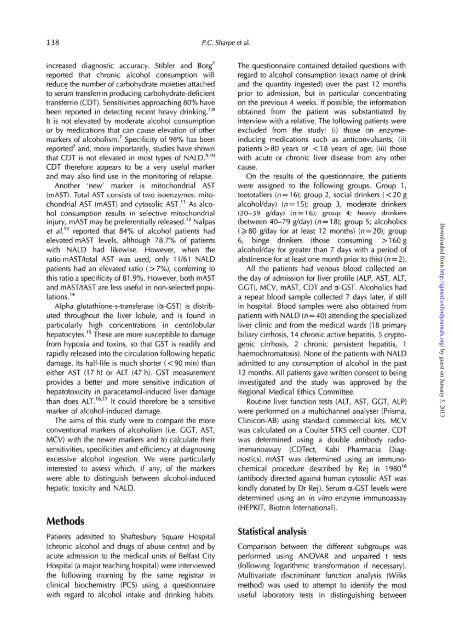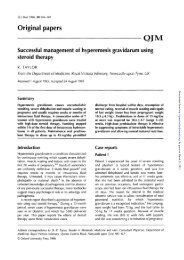Biochemical markers of alcohol abuse - QJM: An International ...
Biochemical markers of alcohol abuse - QJM: An International ...
Biochemical markers of alcohol abuse - QJM: An International ...
Create successful ePaper yourself
Turn your PDF publications into a flip-book with our unique Google optimized e-Paper software.
138 P.C Sharpeeia\.<br />
increased diagnostic accuracy. Stibler and Borg 7<br />
reported that chronic <strong>alcohol</strong> consumption will<br />
reduce the number <strong>of</strong> carbohydrate moieties attached<br />
to serum transferrin producing carbohydrate-deficient<br />
transferrin (CDT). Sensitivities approaching 80% have<br />
been reported in detecting recent heavy drinking. 7 ' 8<br />
It is not elevated by moderate <strong>alcohol</strong> consumption<br />
or by medications that can cause elevation <strong>of</strong> other<br />
<strong>markers</strong> <strong>of</strong> <strong>alcohol</strong>ism. 7 Specificity <strong>of</strong> 98% has been<br />
reported 7 and, more importantly, studies have shown<br />
that CDT is not elevated in most types <strong>of</strong> NALD. 9 ' 10<br />
CDT therefore appears to be a very useful marker<br />
and may also find use in the monitoring <strong>of</strong> relapse.<br />
<strong>An</strong>other 'new' marker is mitochondrial AST<br />
(mAST). Total AST consists <strong>of</strong> two isoenzymes: mitochondrial<br />
AST (mAST) and cytosolic AST. 11 As <strong>alcohol</strong><br />
consumption results in selective mitochondrial<br />
injury, mAST may be preferentially released. 12 Nalpas<br />
et a/. 13 reported that 84% <strong>of</strong> <strong>alcohol</strong> patients had<br />
elevated mAST levels, although 78.7% <strong>of</strong> patients<br />
with NALD had likewise. However, when the<br />
ratio mAST/total AST was used, only 11/61 NALD<br />
patients had an elevated ratio (>7%), conferring to<br />
this ratio a specificity <strong>of</strong> 81.9%. However, both mAST<br />
and mAST/tAST are less useful in non-selected populations.<br />
14<br />
Alpha glutathione-s-transferase (oc-GST) is distributed<br />
throughout the liver lobule, and is found in<br />
particularly high concentrations in centrilobular<br />
hepatocytes. 15 These are more susceptible to damage<br />
from hypoxia and toxins, so that GST is readily and<br />
rapidly released into the circulation following hepatic<br />
damage. Its half-life is much shorter (



